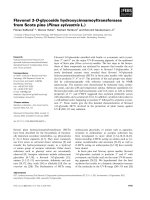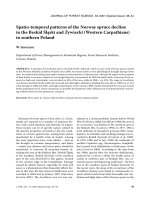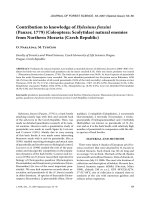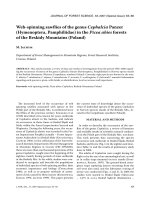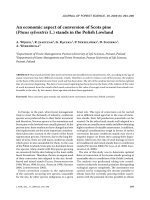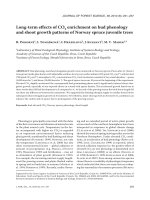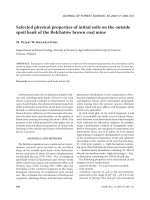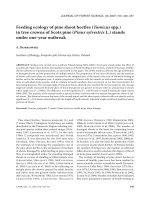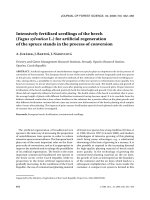Báo cáo lâm nghiệp: "An economic aspect of conversion of Scots pine (Pinus sylvestris L.) stands in the Polish Lowland" docx
Bạn đang xem bản rút gọn của tài liệu. Xem và tải ngay bản đầy đủ của tài liệu tại đây (196.63 KB, 6 trang )
J. FOR. SCI., 55, 2009 (6): 293–298 293
JOURNAL OF FOREST SCIENCE, 55, 2009 (6): 293–298
In Europe, in the past, when forest management
tried to meet the demands of industry, coniferous
species were preferred due to their faster increment
and therefore, Norway spruce in the mountains and
Scots pine in the lowland were usually planted. At the
present time, these tendencies have changed and tree
site requirements are the most important considera-
tions taken into account in the course of the forest
regeneration process. However, due to the long life-
time of trees, there are still many coniferous stands
which grow in sites unsuitable for them. In the case
of the Polish Lowland, Scots pine is a dominant forest
tree species. Many stands with this species growing
on excessively fertile sites belong to the least stable
forest formations. erefore, there is an urgent need
of their conversion into adapted to the site, broad-
leaved and mixed stands (F, R
1998; W 1998; K, P 1998; H
2004; L 2005).
Forest conversion consists in the replacement
of the currently occurring tree species, unsuitable
for the site, by other species indigenous to a given
forest site. is type of conversion can be carried
out at different stand ages but in the case of imma-
ture stands, their full production potentials can be
wasted. On the other hand, stands well-adapted to a
given site are usually more stable and allow obtaining
higher numbers of valuable assortments. In addition,
ecological considerations weigh in favour of earlier
conversion because coniferous stands may exert a
negative impact on forest sites causing their degra-
dation. Moreover, the risk of wind damage is lower
in broadleaved and mixed stands than in coniferous
stands (P 2000; P et al. 2000; G-
et al. 2008).
e aim of this study was to determine optimal
dates of conversion of Scots pine stands growing at
unsuitable sites in conditions of the Polish Lowland.
The analysis was performed taking into consid-
eration exclusively economic premises disregarding
ecological aspects completely. e assessment was
carried out by comparing the income possible to
obtain from the currently growing timber assort-
ments with the potential income possible to obtain
An economic aspect of conversion of Scots pine
(Pinus sylvestris L.) stands in the Polish Lowland
A. W
1
, R. J
1
, G. R
1
, P. S
1
, D. S
1
,
A. W
2
1
Department of Forest Management, Poznan University of Life Sciences, Poznań, Poland
2
Department of Game Management and Forest Protection, Poznan University of Life Sciences,
Poznań, Poland
ABSTRACT: Pine stands at fertile sites need conversion into broadleaved or mixed forests. Yet, according to the age of
stand, conversion may have different economic results. erefore, in order to reduce costs of the process, the analysis
on the basis of the potential income from wood sale has been done. e aim of the analysis has been to find an optimal
date of conversion beginning. e date of conversion beginning has been fixed on the basis of the relation of the value
of wood increment from the stands which need conversion to the value of average wood increment from stands con-
formable to the sites. By this means, three age intervals have been appointed.
Keywords: Pinus sylvestris; pine stands; oak stands; forest conversion; forest sites; Polish Lowland
294 J. FOR. SCI., 55, 2009 (6): 293–298
from the target stand (A 1963; K
1982, 1990; S 1986; K, R
1986; L-S 1991). It is true that prices
of timber assortments as well as mutual relations
between them assumed for the calculations change
in time and are different in different countries or
even regions; nevertheless certain general trends
remain unchanged.
e value of timber production based on prices of
timber assortments is only one of several possible
indicators for making a decision. A decision about
the time of forest conversion could also be based on
other economic indicators, e.g. financial efficiency,
which is an indicator taking into account incomes
and cost of processes.
MATERIAL AND METHODS
All the performed analyses were carried out on the
basis of a computer database of the State Forests for
the region of Wielkopolska (Western Poland) which
provided information concerning 108,000 stands
taking up the area of over 344,500 ha, of which the
area of single-species pine stands was 92,800 ha and
that of mixed stands in which pine was a dominant
species – 37,700 ha (Table 1). e above data was
obtained from the Regional Directorate of the State
Forests in Poznań and derive from the Informatics
System of the State Forests. In business practice
these kinds of data describe in detail characteristics
of individual stands and serve as the basis of forest
management. Data about forests are updated every
10 years by carrying out direct measurements and
descriptions in forests.
The second type of information used in this
study concerns data on the assortment structure of
stands and their value assessed on this basis. is
information was obtained from the Regional Direc-
torate of the State Forests in Poznań and refers to
11,500 stands at different ages. e data was deter
-
mined in two ways. In younger stands, the assort-
ment structure was estimated on the basis of indices
obtained in similar stands during tending fellings. In
older stands, their assortment structure was deter-
mined individually for each stand. e combination
of the above-mentioned two types of information
Table 1. Areas taken up by pine stands at different site types under the administration of the Regional Directorate of the
State Forests in Poznań
Forest site type
Mixed stand with more
than 50% of pine (ha)
Single-species pine stands
(ha)
Sites for coniferous forests 5,147 46,777
Sites for mixed forests with domination of coniferous species 18,632 36,436*
Sites for mixed forests with domination of broadleaved species 11,460* 8,348**
Sites for broadleaved forests 2,496** 1,234***
Total 37,735 92,795
***Conversion is urgent, **conversion is important, *conversion is needed
0
50
100
150
200
250
300
350
400
10 30 50 70 90 110 130 150
Age of stands (years)
(m3/ha)
Pine Oak
Fig. 1. Mean volume of pine and oak
stands at 10-year age intervals
(m
3
/ha)
J. FOR. SCI., 55, 2009 (6): 293–298 295
made it possible to analyze value changes in stands of
different species composition occurring at different
site. Information concerning pine stands requiring
conversion but growing at excessively fertile sites
suitable for broadleaved forests was particularly im-
portant. e data concerning the assortment struc-
ture of stands was collected for several years but the
prices of assortments refer to the year 2004.
At the beginning, mean volumes of pine stands
requiring conversion at the age of 1–160 years as well
as mean volumes of oak stands of the same age range
were calculated. Next, mean timber assortment
values were calculated in €/ha for the two above-
mentioned groups of stands (i.e. requiring conver-
sion and appropriate for the site). In the next step,
mean levels of stand value changes were determined
0
2,000
4,000
6,000
8,000
10,000
12,000
14,000
16,000
18,000
20,000
22,000
10 20 30 40 50 60 70 80 90 100 110 120 130 140 150 160
Age of stands [years]
Oak Pine
Fig. 2. Mean timber values of
pine and oak stands at 10-year
age intervals
Fig. 3. Changes in mean timber
values of pine stands at con-
secutive 10-year age intervals
Fig. 4. Changes in mean timber
values of oak stands at conse-
cutive 10-year age intervals
(€/ha)
(years)
-500
0
500
1,000
1,500
2,000
2,500
3,000
3,500
4,000
10 20 30 40 50 60 70 80 90 100 110 120 130 140 150 160
Age of stands (years)
(EUR/ha)
(€/ha)
–
-2,000
-1,500
-1,000
-500
0
500
1,000
1,500
2,000
10 20 30 40 50 60 70 80 90 100 110 120 130 140 150 160
Age of stands (years)
(EUR/ha)
(€/ha)
–
–
–
–
296 J. FOR. SCI., 55, 2009 (6): 293–298
between the consecutive 10-year age intervals. ese
values were presented in the form of a diagram. A
trend line was determined for pine stands, while for
oak stands the authors marked the horizontal line
which is a mean value. ese two lines juxtaposed in
one diagram illustrate mutual relationships between
pine stands growing at unsuitable sites and oak
stands corresponding to target stands.
RESULTS
The comparison of the mean volume of pine
stands requiring conversion with oak stands re-
vealed the existence of a considerable differences
between them (Fig. 1). Younger pine stands grow-
ing at fertile sites reach higher volumes than their
corresponding oak stands. However, these relation-
ships become reversed with age. Some pine stands
more than 80 years old degrade and their mean
volumes increase no longer, while in the case of oak
stands, their volume keeps increasing until they are
160 years old.
A similar picture is obtained when we compare
the values of pine stands requiring conversion with
their oak counterparts of the same age (Fig. 2). Fig. 3
shows changes in the pine stand values between the
consecutive 10-year intervals. It is quite evident that
the trend line shows a growing tendency only to the
age of approximately 80 years and then falls rapidly.
Fig. 4 shows the same diagram for the oak and the
horizontal line in this diagram shows the mean in-
crement of the stand value for the entire 160-year
period. is line represents the reference level to
which the current value increment of stands requir-
ing conversion is compared. Using the horizontal
line instead of the trend line for the oak is useful
in comparing their value of production with pine,
which has a completely different rotation period.
Fig. 5 collates trend lines of pine and oak stand value
increments. Mutual relations between these lines
made it possible to distinguish three time intervals
in the life of the stand during which different ap-
proaches will be more economical (Table 2). In the
first period (interval A–B), the conversion should
be carried out as quickly as possible. In the middle
period (interval B–C), quick conversion is unprofit-
able and for economic reasons it would be better to
wait until the end of the period. In the last period
(interval C–D), the conversion should also be carried
out as fast as possible.
e necessity of quick conversion in the last period
is obvious because its postponement means financial
losses. However for younger stands (interval A–C)
the sum of the expected value increments of stands
-2,000
-1,500
-1,000
-500
0
500
1,000
1,500
2,000
10 20 30 40 50 60 70 80 90 100 110 120 130 140 150 160
Age (years)
oak stands pine stands
Fig. 5. Relation between mean
timber values of pine stands
and mean timber values of oak
stands at consecutive 10-year
age intervals
Table 2. Age intervals and optimal dates of conversion of pine stands (Fig. 5)
Age interval Optimal date of conversion
Between points A and B – younger stands as soon as possible
Between points B and C – middle age stands at the end of the period – at point C
Between points C and D – older stands as soon as possible
(€/ha)
–
–
–
–
Oak stands
Pine stands
О
A
О
C
О
D
О
B
J. FOR. SCI., 55, 2009 (6): 293–298 297
to the point C (90 years of age) was calculated. And
in the period A–B the sum of the expected value
increments of stands was larger for oak but in the
period B–C it was larger for pine.
CONCLUSIONS
e analyses carried out on the basis of data con-
cerning forests administered by the Regional Direc-
torate of the State Forests in Poznań allowed drawing
the following conclusions:
– With the passage of time, changes in the mean
volume of Scots pine stands growing at unsuitable
sites and oak stands growing at appropriate sites
follow different pathways.
– e increment rate of the mean value of pine
stands from unsuitable sites is initially greater
than that of oak stands but these relationships get
reversed at older age.
– e mean value of pine stands from unsuitable
sites increases only to the age of 80 years and later
on this value decreases significantly.
– For economic reasons, the conversion of pine
stands growing at unsuitable sites in conditions
of the Polish Lowland should be conducted either
at a very young age or should be carried out in
mature stands.
R e f e r e n c e s
ANCUKIEWICZ O., 1963. Metodyka określania efektu
ekonomicznego przebudowy drzewostanów małowarto-
ściowych. Sylwan, 6: 27–36.
FILIUS B.M., ROOSENSCHOON O.R., 1998. Tree species
conversion to diminish forest’s water use – financial con-
sequences of a controversial forest management practice in
the Netherlands. Journal of Forest Economics, 4: 85–102.
GARDINER B., BYRNE K., HALE S., KAMIMURA K.,
MITCHELL S.J., PELTOLA H., RUEL J.C., 2008. A review
of mechanistic modelling of wind damage risk to forests.
Forestry, 81: 447–463.
HANSEN J., 2004. Conversion of coniferous forests – will
ecological and economic needs meet? EFI News, 12: 3–6.
KAZDA M., PICHLER M., 1998. Priority assessment for
conversion of Norway spruce forests through introduction
of broadleaf species. Forest Ecology and Management, 102:
245–258.
KLOCEK A., 1982. Optymalizacja wieku dojrzałości rębnej
oraz wieku przebudowy drzewostanów. Sylwan, 4: 1–9.
KLOCEK A., 1990. Optimizing the age of final cutting in
normal and intentional forest. Folia Forestalia Polonica,
32: 65–83.
KLOCEK A., RUTKOWSKI B., 1986. Optymalizacja regulacji
użytkowania rębnego drzewostanów. Warszawa, PWRiL.
LOEWENSTEIN E.F., 2005. Conversion of uniform broad-
leaved stands to an uneven-aged structure. Forest Ecology
and Management, 215: 103–112.
LORRAIN-SMITH R., 1991. e cost of conservation in
woodland managed for timber production. Quarterly
Journal of Forestry, 85: 43–49.
PELTOLA H., GARDINER B., KELLOMÄKI S., KOLSTRÖM
T., LÄSSIG R., MOORE J., QUINE C.P., RUEL J.C., 2000.
Introduction – Wind and other abiotic risks to forests.
Special Issue Wind and other abiotic risks to forests. Forest
Ecology and Management, 135: 1–2.
PETERSON CH.J., 2000. Damage and recovery of tree species
after two different tornadoes in the same old growth forest:
a comparison of infrequent wind disturbances. Special Issue
Wind and other abiotic risks to forests. Forest Ecology and
Management, 135: 237–252.
STĘPIEŃ E., 1986. Przesłanki wyznaczania terminu przebu-
dowy drzewostanów sosnowych na niewłaściwym siedlisku.
Sylwan, 4: 17–26.
WANG G.G., 1998. An ecologically based model for site in-
dex conversion among species. Canadian Journal of Forest
Research, 28: 234–238.
Received for publication October 10, 2008
Accepted after corrections January 6, 2009
Ekonomický aspekt přeměny porostů borovice lesní (Pinus sylvestris L.)
v Polské nížině
ABSTRAKT: Borové porosty na úrodných stanovištích mají být přeměněny na listnaté nebo smíšené lesy, ale podle
věku porostu může mít tato přeměna různé ekonomické výsledky. Za účelem snížení nákladů na tento proces byla
provedena analýza na základě potenciálních příjmů z prodeje dřeva. Cílem analýzy bylo najít optimální čas pro zahá-
298 J. FOR. SCI., 55, 2009 (6): 293–298
Corresponding author:
Ing. A W, Ph.D., Poznan University of Life Sciences, Department of Forest Management,
Wojska Polskiego 71C, 60-625 Poznań, Poland
tel.: + 48 618 487 667, fax: + 48 618 487 662, e-mail:
jení přeměny. Ten byl určen podle vztahu hodnoty přírůstu dřeva z porostů, jež potřebují přeměnu, a hodnoty prů-
měrného přírůstu dřeva z porostů odpovídajících stanovištím. Tímto způsobem byly určeny tři věkové intervaly.
Klíčová slova: Pinus sylvestris; borové porosty; dubové porosty; přeměna lesa; lesní stanoviště; Polská nížina
